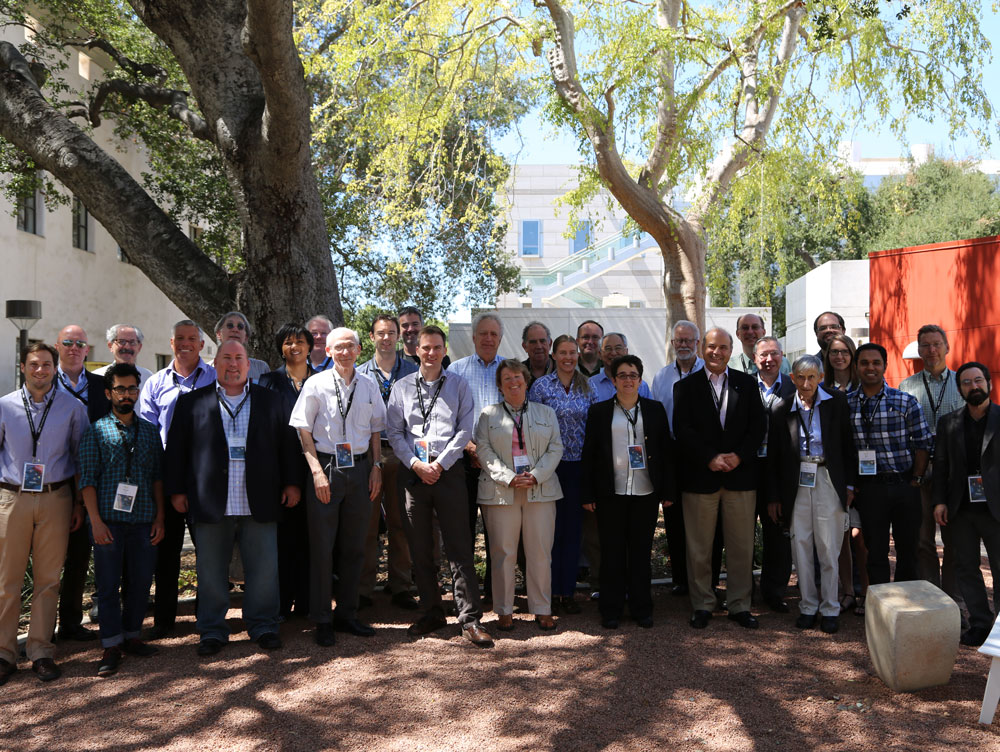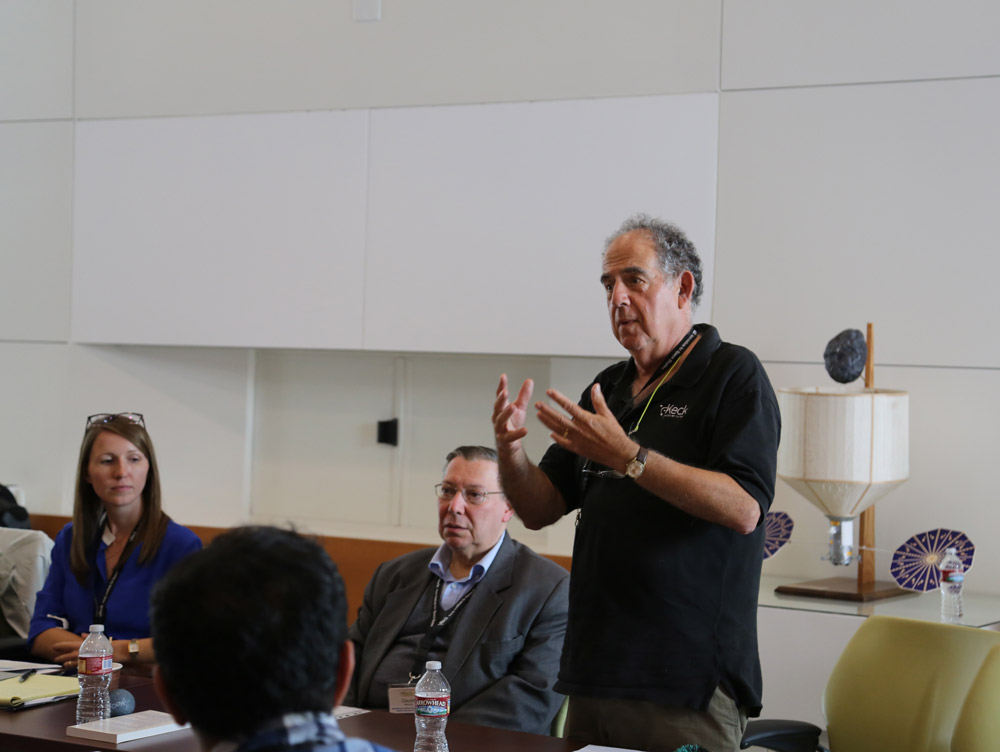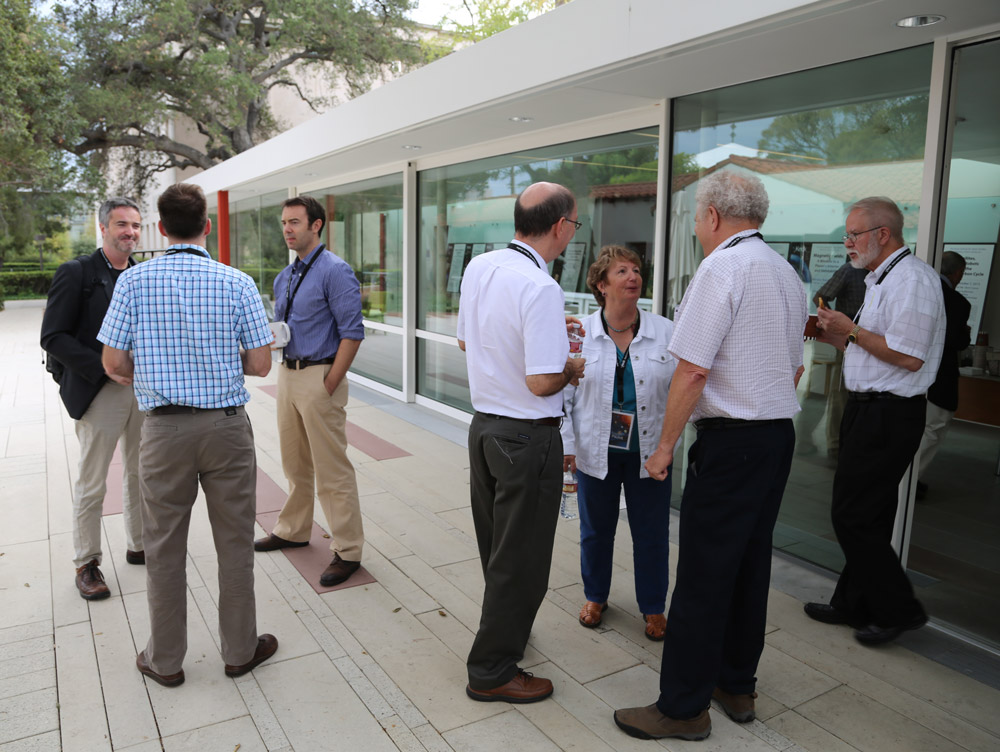Science and Enabling Technologies to Explore the Interstellar Medium
September 8-11, 2014
California Institute of Technology -
Pasadena, CA 91125
Final Report
Important Information about the KISS ISM Program: 2017 press articles appear to have included erroneous information about a Keck Institute (KISS) study. KISS has not produced a study about using SpaceX's BFR to get to 'Oumuamua. KISS did convene a program to study possibilities for future missions to reach the interstellar medium outside the solar system, but that study took place before the discovery of 'Oumuamua and is not applicable to that object.
Workshop Overview:
Recent discoveries reported in 2012 and 2013 by Voyager-1 and Kepler have brought into focus two end-points of what is now commonly referred to as the Interstellar Medium (ISM). Whereas Voyager-1 is beginning to explore the ISM in-situ, the Kepler space-based telescope and other Earth-based telescopes have detected a plethora of potentially Earth-like planetary systems around other stars or "exoplanets". The results of these two missions frame the context for further intellectual curiosity, scientific questions, and exploration goals that will define objectives for innovative and far-reaching missions heading out of our solar system and someday reaching for the stars.
The goals of the workshop are to:
- articulate key scientific questions
- identify near-term science exploration goals
- derive mission objectives and preliminary design concepts that can be realized in the next two decades
- derive flight system and science measurement requirement
- assess key mission, system, and operations technology drivers
- develop a technology maturation plan that will be proposed to KISS and JPL for follow-on funding.
The technical challenge and the focus of the workshop is to assess mission implementation techniques that will enable affordable robotic probes to reach the ISM within 10 years with velocities up to 10 times faster than Voyager, and be designed to last 50 years or longer. By comparison, Voyager-1 is now traveling at a speed of 17 km/sec, and has taken 35 years to reach the ISM. Meeting this challenge would constitute a revolutionary capability that would enable multiple scientific probes to launch and return initial scientific results of and from the ISM within a decade, and continue for several decades.
Workshop Participants:
- Leon Alkalai - JPL/Caltech
- Nitin Arora -JPL/Caltech
- Manan Arya - Caltech Campus
- Nathan Barnes - L'Garde Inc.
- Mike Brown - Caltech Campus
- Bob Cesarone - JPL/Caltech
- Freeman Dyson - Institute for Advanced Study
- Lou Friedman - The Planetary Society
- Darren Garber - NXTRAC
- Paul Goldsmith - JPL/Caltech
- Mae Jemison - 100 Year Starship
- Les Johnson - NASA George C. Marshall Space Flight Center
- Paulett Liewer - JPL/Caltech
- Philip Lubin - UC Santa Barbara
- Claudio Maccone - International Academy of Astronautics/Istituto Nazionale di Astrofisica
- Jared Males - University of Arizona
- Ralph McNutt - Johns Hopkins University Applied Physics Laboratory
- Richard Mewaldt - Caltech Campus
- Adam Michael - Boston University
- Merav Opher - Boston University
- Elena Provornikova - Catholic University of America
- Jamie Rankin - Caltech Campus
- Seth Redfield - Wesleyan University
- Michael Shao - JPL/Caltech
- Ed Stone - Caltech Campus
- Nathan Strange - JPL/Caltech
- Mark Swain - JPL/Caltech
- Slava Turyshev - JPL/Caltech
- Michael Werner - JPL/Caltech
- Gary Zank - Univesity of Alabama in Huntsville
Reference List
Below are some references we have gathered relevant to our study. Many more references about particular technologies, scientific investigations, and orbits will be cited during the study. We welcome additions and suggestions for this compilation of references.
Interstellar Precursors (e.g. 50-1000 AU)
- "Evolutionary Lightsailing Missions for the 100-year Starship"
by L. Friedman, D. Garber and T. Heinsheimer - "FOCAL: Deep Space Science and Telecommunications Using the Sun's Gravitational Lens" by L. Johnson, C. Maccone, E. Davis,
and M. LaPointeiv - "The Sun as a Gravitational Lens: A Target for Space Missions Reaching 550 AU to 1000 AU" by C. Maccone
- "The 550-au mission: a critical discussion" by S. G. Turyshev
and B-G. Andersson - "Solar System Escape Architecture for Revolutionary Science (SSEARS)" NIAC study by J. Nosanov
- "Enabling interstellar probe" by R. L. McNutt Jr. and R. F. Wimmer-Schweingruber
- "Interstellar Probe: Impact of the Voyager and IBEX results on science and strategy" by R. L. McNutt Jr., M. Gruntman, S. M. Krimigis, E. C. Roelof, and R. F. Wimmer-Schweingruber
- Previous Interstellar Precursor Studies
- "Leaving the Heliosphere: A Nuclear Powered Interstellar Probe" , T. H. Zurbuchen, P. Patel, L. A. Fisk, G. Zank, R. Malhotra, H. O. Funsten, and R. A. Mewaldt, in NASA Space Science Vision MIssions, Mac S. Allen, Ed., 2008.
- "Scientific Payload for an Interstellar Probe Mission", R. A. Mewaldt, P. C. Liewer, and the Interstellar Probe Science and Technology Definition Team, in The Outer Heliosphere: The Next Frontiers, COSPAR Colloquia Series Vol. 11, edited by K, Scherer et al., Pergamon (2001).
- "Interstellar Heliospheric Probe/Heliospheric Boundary Explorer Mission- a Mission to the Outermost Boundaries of the Solar System", R. F. Wimmer-Scweingruber, R. McNutt, N. A. Schwadron, R. C. FRisch, M. Gruntman, P.Wurz, E. Valtonen, and the IHP/HEX Team. Exp. Astron. (2009) 24:9-46, doi 10.1007/s10686-008-9134-5.
- "Interstellar Probe using a Solar Sail: Conceptual Design and Technological Challenges", P. C. Liewer, R. A. Mewaldt, J. A. Ayon, C. Garner, S. Gavit, and R. A. Wallace, in The Outer Heliosphere: The Next Frontiers, COSPAR Colloquia Series Vol. 11, edited by K, Scherer et al., Pergamon (2001).
- L. Friedman, D. Garber. Science and Technology Steps Into the Interstellar Medium, IAC-14,D4,4,3,x22407, 2014.
- "A Small Interstellar Probe to the Heliospheric Boundary and Interstellar Space" by R. A. Mewaldt et al.
- R. L. McNutt, Jr., R. W. Lyman, M. E. Ewing, R. S. Krishnan, D. M. Lester. AIAA 2001-3377 Solar Thermal Propulsion for an Interstellar Probe. 37th AIAA/ASME/SAE/ASEE Joint Propulsion Conference. July 8-11, 2001.
- B. G. Boone, R. S. Bokulic, G. B. Andrews, R. L. McNutt, Jr.
and N. Dagalakis. Optical and microwave communications system conceptual design for a realistic interstellar explorer.
The JPL Library compiled this selective list of publications. The emphasis is upon review articles and publications from 2000 to the current date.
Interstellar Flight (i.e. to other star systems)
Actual Interstellar Flight is not part of our study. It is too far out. But the idea of interstellar flight motivates interest in missions that explore into the interstellar medium (ISM) and make observations from the ISM. And the reverse: ideas to exit the solar system at high velocities to hundreds of AU naturally lead to thinking about possibilities beyond that. There is a rich literature about interstellar flight, most of it science-fiction, but also some technical papers, especially in the Journal of the British Interplanetary Society and on the web sites of organizations devoted to research and studies about the topic. A compendium of literature and organizations is given in the following:
Short Course Presentations |
|
Ed Stone |
The Interstellar Medium |
|
Freeman Dyson |
Missions Beyond Pluto |
|
Mike Brown |
Kuiper Belt, Oort Cloud |
|
Slava Turyshev |
The Solar Gravity Lens Focus |
|
Ralph McNutt |
Previous ISM Mission Studies |
|
Nathan Strange |
How Fast, How Far |
|
Les Johnson |
Propulsion Candidates |
Workshop Presentations |
|
Michele Judd, Leon Alkalai, Lou Friedman, Ed Stone |
Logistics and Objectives |
Seth Redfield |
Science Objectives Heliophysics (2.4 MB .pdf) |
|
Merav Opher |
Science Questions from inside 150AU Heliosheath/Heliopause |
|
Slava Turyshev |
Science Objectives in Astrophysics |
Post-Workshop Presentations |
|
|
Leon Alkalai, Ed Stone, Lou Friedman |
Post Workshop: Summary of Action Items |




















